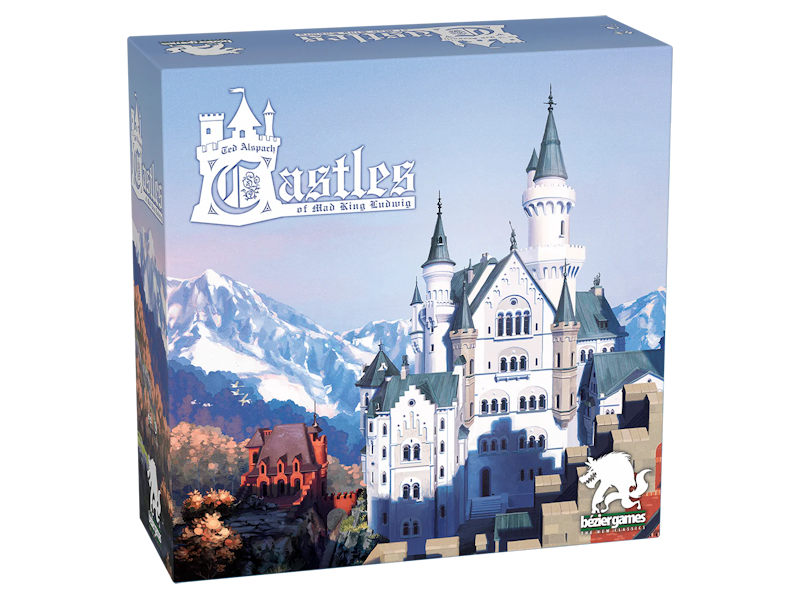Castles of Mad King Ludwig
review by Luka
What is Castles of Mad King Ludwig?
Castles of Mad King Ludwig is a 1-4 player tile-placing game where players, embodying the role of contractors, are challenged to build the best castle for Bavarian King Ludwig II by purchasing and configuring Room tiles. To earn money, other contractors buy Room tiles from you when you acquire the rotating role of “Master Builder.” Once the game ends, the contractor who has the best castle is determined by their Victory Point score. Victory points are scored through a variety of ways, including the Room tiles’ points values and secret objective “Bonus” cards.
Set up
Set up for Castles of Mad King Ludwig is fairly simple, allowing you to quickly get into the gameplay. To begin, a number of Room tiles and cards are set on the game board face down in piles based on the number of players. Then an amount of King’s Favor tokens are randomly selected to be present for the game. These are public objectives each player competes over to do the best in.
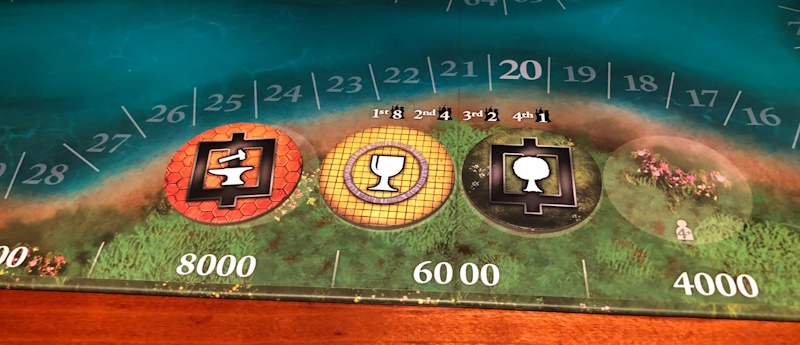 An example of King’s Favor tokens. These encourage players to compete for the most square footage of Utility and Outdoor Rooms, and to have the most Food Rooms.
An example of King’s Favor tokens. These encourage players to compete for the most square footage of Utility and Outdoor Rooms, and to have the most Food Rooms.
Next, each player receives a number of coins worth 15,000 (money values are measured in the thousands), and 3 Bonus cards. Of the Bonus cards they receive, they pick two to keep and return the other to the bottom of the bonus card deck. Nearly done, each player chooses a color. Beyond the aesthetics of the player’s starting Foyer Room tile, the color determines which swan on the game board tracks their score. Finally, one player is chosen to start as Master Builder, placing their swan score marker on 0, with every player afterward placing their score at one more point than the previous player. With that, the game begins.
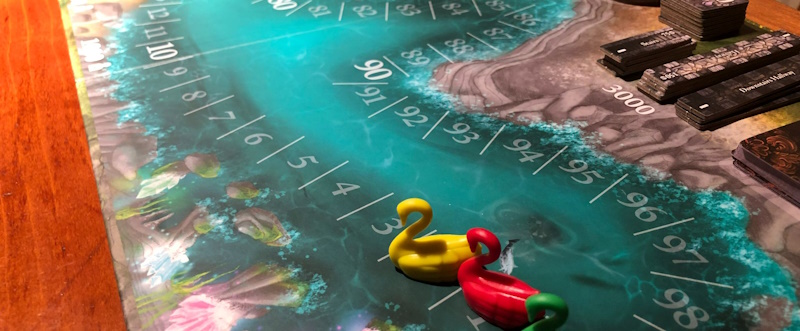 The swans at the starting points value: green starts the game as the Master Builder, with red being second and yellow being third.
The swans at the starting points value: green starts the game as the Master Builder, with red being second and yellow being third.
Gameplay
The core gameplay loop revolves around the Master Builder revealing Room cards, which determine what size Room tiles are added to the market, setting the price for each Room, then going around the table giving everyone an opportunity to purchase a Room tile to place in their castle for points. Then all tiles not bought are discounted by 1,000 for the next round and the next round begins with the same process, with new tiles being added to the market via Room cards, the next Master Builder pricing them.
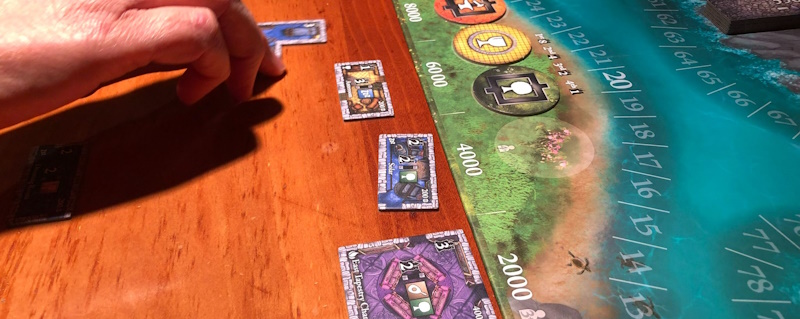 The current Master Builder sets the prices of current Room tiles for all players.
The current Master Builder sets the prices of current Room tiles for all players.
When players purchase Room tiles, the money goes to the current Master Builder. However, the Master Builder is the last one who can purchase a Room in a round and the money they spend is returned to the general supply.
After buying a Room tile, the player places it connecting to another available doorway. When doing so, they score points equal to the number of points on the upper left-hand side of the tile. In addition, more points are scored or lost depending on your placement and Room type. Some Rooms have connection bonuses which score you additional points when connected to the desired Room type. These include Rooms that a player has already placed. You can also lose points from adjacency penalties, which occur when a Room is next to (not necessarily connected to) another Room of a specific type. And some Downstairs Rooms score you more points for each Room of a type you have in your castle! The type of the Room is color-coded, with a symbol designating it in the lower left of the tile.
 An Observatory Room tile. The points value is in the upper-left, the size is in the upper-right, the type of Room (Living Room) is identified by the symbol in the bottom left, and the center displays connection bonuses to other Living Rooms and Activity Rooms, granting 2 points for each.
An Observatory Room tile. The points value is in the upper-left, the size is in the upper-right, the type of Room (Living Room) is identified by the symbol in the bottom left, and the center displays connection bonuses to other Living Rooms and Activity Rooms, granting 2 points for each.
When all the doors of a Room have been connected to doors of other Rooms, the player gets a completed Room. Depending on the type of Room, the player receives a particular Room bonus. For example, Utility Rooms allow the player to draw two more Bonus cards and keep 1 to add to the score later, which Outdoor Rooms grant the player 10,000 in coins once completed.
 In this example, a player has 7 Rooms completed: both Utility Rooms, all three Sleeping Rooms, the larger Living Room, and the Outdoor has all doors connecting to other doors.
In this example, a player has 7 Rooms completed: both Utility Rooms, all three Sleeping Rooms, the larger Living Room, and the Outdoor has all doors connecting to other doors.
Once the Room card deck has run out of cards, the game ends and final scoring is counted. If a Room tile pile is empty, each Room of that size adds 2 Victory Points to their player’s score. Then the King’s Favor public objective rankings are calculated with first place for each objective scoring 8 Victory Points, and each successive ranking down scoring half of the place ahead of them. Next Bonus card private objective points are counted up, with every 10,000 money leftover becoming 1 Victory Point.
Review
Castles of Mad King Ludwig offers a very enjoyable experience when playing with friends or family. It has been one of the easiest to teach long-format games I’ve played with my parents, with enough strategy to keep everyone engaged and excited. Not only is the game easy to set up and play, but the game provides many helpful reminders through a cheat sheet for each player that reminds them of each Room’s completion bonus, and the board itself denoting how many tiles are needed for each stack of Room tiles, where to stack them, what the prices that can be set are, or how many Room cards are needed depending on number of players.
Player strategy also maintains a lot of depth. Through the King’s Favor tokens, Bonus cards, and Room completion bonuses, players are incentivized to score points in a variety of ways with different strategies. The first time I played, I had a Bonus card that rewarded me for having as many Sleeping Rooms as possible. It so happened that Sleeping Rooms also had the Room completion bonus of placing up to two Room tiles on deck to be added to the market next round. In doing so, I also leaned into a strategy of buying all 200 square feet Rooms as I quickly emptied their stack. However, I had to be wise when completing my Rooms; if I completed a Sleeping Room the round just before I become Master Builder, other players will have the chance to snag all the 200 square feet Rooms I stacked on the deck. To contrast with this strategy on my second playthrough, I took advantage of Utility Rooms to score as many Bonus cards gained from their completion rewards.
Additionally, once you end the game, you can always feel satisfied about your completed castle, even if you don’t win.
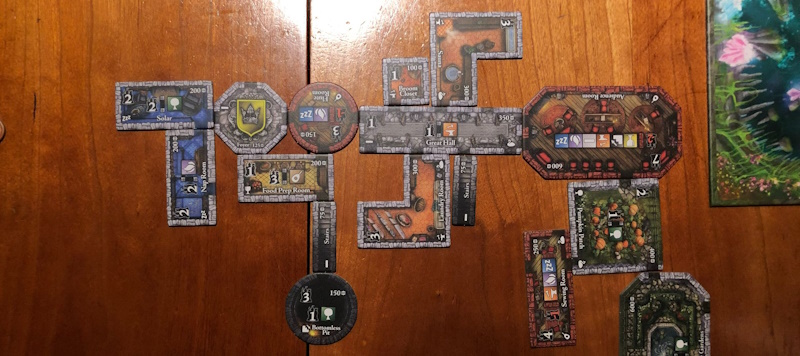 My modest sized castle during my second game.
My modest sized castle during my second game.
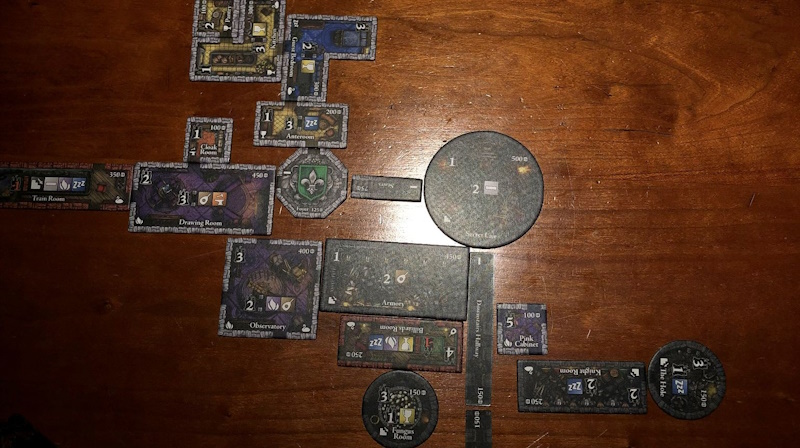 The winning castle from my second game.
The winning castle from my second game.
One of my only gripes is that there’s no locking mechanism for the Room tiles. So if you accidentally shift some Room tiles in your castle, they will end up being disarrayed. I also dislike how Room types of a tile are denoted by a tiny symbol in the bottom left of it, making it hard to spot. I also must warn you that the solo mode of the game doesn’t have you pitched against an automated opponent, but rather it has you trying to reach a high score for its own sake. Despite these critiques, having the tiles be free makes the game pieces easy to store and handle, especially considering the box comes with component organizers already (further making setting up a breeze)! And the Room types themselves are color-coded, so I quickly began identifying Rooms by their color rather than the symbol in the bottom left.
Overall, I really enjoy the game and it will remain a mainstay for me and my family! I recommend Castles of Mad King Ludwig to families or friends looking to add a new board game to bonding times that offer a bit more complexity than games like Azul or Sagrada.
Castles of Mad King Ludwig is available now from our webstore.
